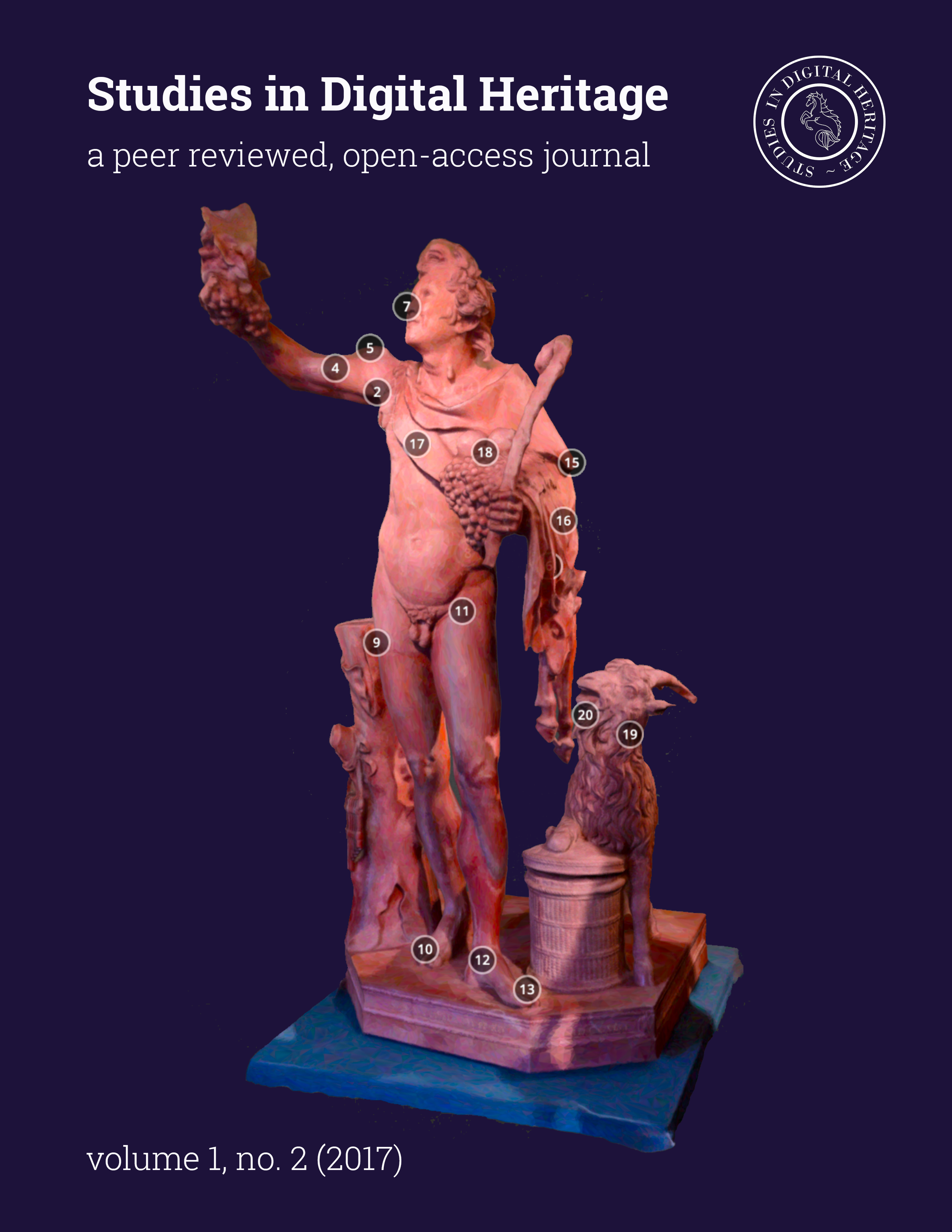High precision laser scanning assisting in the service of historical and art historical research. The burial monument of Queen Gertrude (13th century)
Main Article Content
Abstract
This paper will present the results of a new research project to create the first virtual reconstruction of the burial monument. The fragments of the monument and its previously sculpted physical model were captured by a terrestrial laser scanner and an optical 3D scanner, and consequently, point clouds and meshes were created. Using high-resolution data in CAD environment, a 3D virtual reconstruction model was built showing a possible form of the burial monument. In order to offer a new virtual reconstruction for different research approaches (art historical studies, archaeological interpretations and comparative studies with other monuments) a complex method was required to handle the huge amount of digital data. A database was built from the scanned fragments enabling to manage them easily. High precision 3D models of the fragments allowed to capture their precise geometry and perform the metrical analysis of the fragments, which may provide a basis for alternative reconstruction attempts. By using 3D technology, the results and conclusions derived from the fragments have been made more accessible than through traditional methods. Thus, scholars can use spectacular 3D visualizations in their research and examine many properties of the artifacts. The results are also available for a wider audience, as it has been demonstrated in an exhibition to commemorate the 800th anniversary of the death of Queen Gertrude. The paper demonstrates some of the advantages that 3D technology provides for scholarly research over conventional methods and introduces a method for integrated archaeological, historical and art historical examinations using state of the art technologies.
Downloads
Article Details
From 18 May 2018, the contents of Studies in Digital Heritage are licensed under a Creative Commons Attribution-NonCommercial 4.0 International License (CC BY-NC 4.0). Our submitting authors pay no fee and retain the copyright to their own work.
How this works: to submit their work to the journal, authors grant Studies in Digital Heritage a nonexclusive license to distribute the work according to a CC BY-NC 4.0 license. Once an article is published, anyone is free to share and adapt its contents—provided only that they do so for noncommercial purposes and properly attribute the shared or adapted information. Details of these terms can be found on the Creative Commons website.
Download SDH’s full author agreement here
Studies in Digital Heritage will insert the following note at the end of any work published in the journal:
© [Year] by the authors. This article is an open-access article distributed under the terms and conditions of the Creative Commons Attribution License CC BY-NC 4.0 (https://creativecommons.org/licenses/by-nc/4.0/).
References
Elek Benkő. 2014. Gertrúd királyné sírja a pilisi ciszterci monostorban. In Egy történelmi gyilkosság margójára : Merániai Gertrúd emlékezete, 1213-2013. Szentendre: Ferenczy Múzeum, 173–188.
László Gerevich. 1971a. A gótikus klasszicizmus és Magyarország. Magy. Tudományos Akadémia Filozófiai és Történettudományi Osztályának Közleményei 20., 1–2. (1971), 55—72.
László Gerevich. 1971b. Villard de Honnecourt Magyarországon. Művészettörténeti Értesítő 20. (1971), 81—105.
László Gerevich. 1985. A pilisi ciszterci apátság. Stud. Com. 17. (1985), 541—545.
Gabriele Guidi, Michele Russo and Davide Angheleddu. 2014. 3D Survey and Virtual Reconstruction of archeological sites. Digit. Appl. Archaeol. Cult. Herit. 1 (2014), 55–69. doi:10.1016/j.daach.2014.01.001
Hans R. Hahnloser. 1972. Villard de Honnecourt. Kritische Gesamtausgabe des Bauhüttenbuchs Ms. fr. 19093 dér Pariser Nationalbibliothek, Graz: Akademische Druck.
József Laszlovszky and József Szentpéteri. 2014. “...Scripta manent”. Emlékképek a pilisi úgynevezett Gertrúd-sír megtalálásának körülményeiről. In Judit Majorossy, ed. Egy történelmi gyilkosság margójára : Merániai Gertrúd emlékezete, 1213-2013. Szentendre: Ferency Múzeum, 163—172.
József Laszlovszky and József Szentpéteri. 2014. “...Scripta manent”. Emlékképek a pilisi úgynevezett Gertrúd-sír megtalálásának körülményeiről. In Judit Majorossy, ed. Egy történelmi gyilkosság margójára : Merániai Gertrúd emlékezete, 1213-2013. Szentendre: Ferency Múzeum, 163—172.
London Charter. (2009). Retrieved October 1, 2016 from http://www.londoncharter.org/
Vilmos Osgyányi. 1985. Kőszobrász-restaurátori megfigyelések a pilisi Gertrudisz-síremlék töredékeinek rekonstrukciós feldolgozásához. Régészeti tanulmányok Pest megyéből, Studia Comitatensia(17.), pp. .. Takács, I., . Getrudis királyné síremléke. In: Á. Mikó & I. Takács, szerk. Régészeti tanulmányok Pest megyéből Studia Com, 17 (1985), 603—619.
Michele Russo and Gabriele Guidi. 2011. Diachronic 3D reconstruction for lost cultural heritage. In Remondino, ed. 4th International Workshop 3D-ARCH 2011. ISPRS, Trento, Italy, 1–6. doi:10.2423/i22394303v1n2p71
Szime 3D (2013). Retrieved January 20, 2017 from http://szime3dar.com/en/ Imre Takács. 1994. Getrudis királyné síremléke. In Árpád Mikó & Imre Takács, eds. Pannonia Regia, Művészet a Dunántúlon 1000-1541. Budapest: Magyar Nemzeti Galéria, 248—256.
Imre Takács. 2014. A Gertrúd - síremlék rekonstrukciójának kérdései. In Judit Majorossy, ed. Egy történelmi gyilkosság margójára : Merániai Gertrúd emlékezete, 1213-2013. Szentendre: Ferenczy Múzeum, 189—202.
Imre Takács. 2015. The tomb of Queen Gertrude. Acta Hist. Artium 56 (2015), 5—88.


